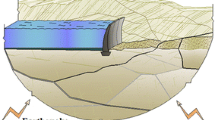Abstract
In this study, a nonlinear model is presented for analysis of damage-cracking behavior in arch dams during strong earthquakes using different seismic input mechanisms. The nonlinear system includes a plastic-damage model for cyclic loading of concrete considering strain softening and a contact boundary model of contraction joint opening. Two different earthquake input mechanisms are used for comparison, including massless foundation input model and viscous-spring boundary model considering radiation damping due to infinite canyon. The results demonstrate that effects of seismic input mechanism and radiation damping on nonlinear response and damage-cracking of the dam are significant. Compared with the results of using massless foundation input model, the damage-cracking region and contraction joint opening are substantially reduced when using viscous-spring boundary model to take into account radiation damping. However, if the damping ratio of the dam is artificially increased to about 10%–15% for massless foundation input model, the joint opening and damage-cracking of the dam are comparable to the results obtained from the viscous-spring boundary model.
Similar content being viewed by others
References
Yuan Z J. Influence of high in-situ stress on stability of dam foundation rock (in Chinese). Sichuan Water Power, 1999, 18(3): 25–27
Wu Z R. Study on the effect of the substitution for faults in abutment of arch dam (in Chinese). J East China Tech U Water Res, 1985, 13(3): 31–41
Wu Z R, Li J, Gu C S, et al. Review on hidden trouble detection and health diagnosis of hydraulic concrete structures (in Chinese). Sci China Ser E-Tech Sci, 2007, 50(Suppl 1): 34–50
Gu C S, Wu Y, Su H Z, et al. A new method of estimating the equivalent elastic modulus of RCCD (in Chinese). Sci China Ser E-Tech Sci, 2007, 50(Supp 1): 136–143
Gu Y C, Zhang D J, Guo H Z, et al. Regression analysis of 3D initial geostress field for dam site of Xiaowan Hydropower Station (in Chinese). Rock Soil Mech, 2008, 29(4): 1015–1020
Gu Y C. Study on establishing methods of multistage deformation forecasting indexes of super high arch dam for high geo-stress zone (in Chinese). Dissertation of Doctoral Degree. Hohai: Hohai University, 2008
Wu Z R. Safety Monitoring Theory and Its Application of Hydraulic Structure (in Chinese). Beijing: Higher Education Press, 2003
Gu Y C, Cong P J, Jin Y Q, et al. Back analysis for dam base deformation modulus based on increment displacement model in construction (in Chinese). J Hydro Eng, 2008, 27(3): 54–59
Author information
Authors and Affiliations
Corresponding author
Additional information
Supported by the National Natural Science Foundation of China (Grant Nos. 50539110, 50809025, 50539010, 50579010, 50539030) and the Science and Technology Support Plan (Grant Nos. 20006BAC14B03, 2008BAB29B03)
Rights and permissions
About this article
Cite this article
Wu, Z., Gu, Y., Su, H. et al. Mechanical effects of excavation rebound of arch dam bedrock and better concreting time of dam body. Sci. China Ser. E-Technol. Sci. 52, 513–517 (2009). https://doi.org/10.1007/s11431-009-0043-2
Received:
Accepted:
Published:
Issue Date:
DOI: https://doi.org/10.1007/s11431-009-0043-2




